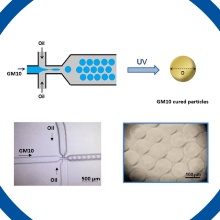To generate gelatin-based hydrogel particles, an aqueous gelatin solution with the proper surfactant is introduced into a continuous oil phase and then subsequently solidified either physically or chemically. While this method is straightforward, it results in materials with limited surface areas and with inhomogeneous particle sizes which are drawbacks for potential drug release applications.
This project aims to synthesize gelatin-based materials with large surface areas, specifically hydrogel particles, with homogeneous radii from 50 to 100 µm. The overarching objective is to regulate the diffusion paths of model drugs and, consequently, their release kinetics by manipulating the particle size. Further control parameters for release kinetics include drug concentration and the isoelectric point (IEP) of the hydrogel. We will study the release kinetics of model drugs as function of the particle size and the particle size distribution. By adjusting both the IEP and the drug concentration, materials with precisely tunable release rates will be fabricated. This involves the synthesis and characterization of gelatin-based hydrogel particles with tailored composition and size. Additionally, we will explore the adsorption and release behavior of these materials for three different model drugs. Ultimately, selected samples will undergo release kinetics studies in a physiological buffer at 37°C to simulate biologically relevant conditions.

Omar Abdelaziz Mohamed
PhD Student

Cosima Stubenrauch
Prof. Dr.Dean of Faculty
- Profile page
- +49 711 685 64470
- Write e-mail
- Secretary: Room 9-302; Tel. +49 711 685-64451 and -64393; sekretariat2@ipc.uni-stuttgart.de


